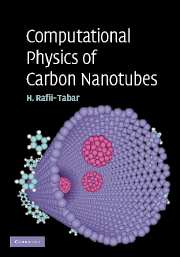Book contents
1 - Introduction
Published online by Cambridge University Press: 29 September 2009
Summary
Carbon is a unique and, in many ways, a fundamental element. It can form several different structures, or allotropes. Up to the end of the 1970s, diamond, graphite and graphite-based fibres were the only known forms of carbon assemblies. The discovery in 1985, and subsequent synthesis, of the class of cage-like fullerene molecules, starting with the discovery of the spherically shaped C60 buckyball molecule composed of 20 hexagonal and 12 pentagonal carbon rings, led to the emergence of the third form of condensed carbon. By the beginning of the 1990s, elongated forms of the fullerene molecule, consisting of several layers of graphene sheets, i.e. graphite basal planes, rolled into multi-walled cylindrical structures and closed at both ends with caps containing pentagonal carbon rings, were discovered. Soon afterwards, another form of these cylindrical structures, made from only a single graphene sheet, was also discovered. These two structures have come to be known as carbon nanotubes, and they form the fourth allotrope of carbon.
Three experimental techniques have so far become available for the growth of carbon nanotubes. These are the arc-discharge technique, the laser ablation technique and, recently, the chemical vapour deposition technique. The use of these techniques has led to the worldwide availability of this material, and this has ushered in new, very active and truly revolutionary areas of fundamental and applied research within many diverse and already established fields of science and technology, and also within the new sciences and technologies associated with the new century.
Information
- Type
- Chapter
- Information
- Computational Physics of Carbon Nanotubes , pp. 1 - 12Publisher: Cambridge University PressPrint publication year: 2007
